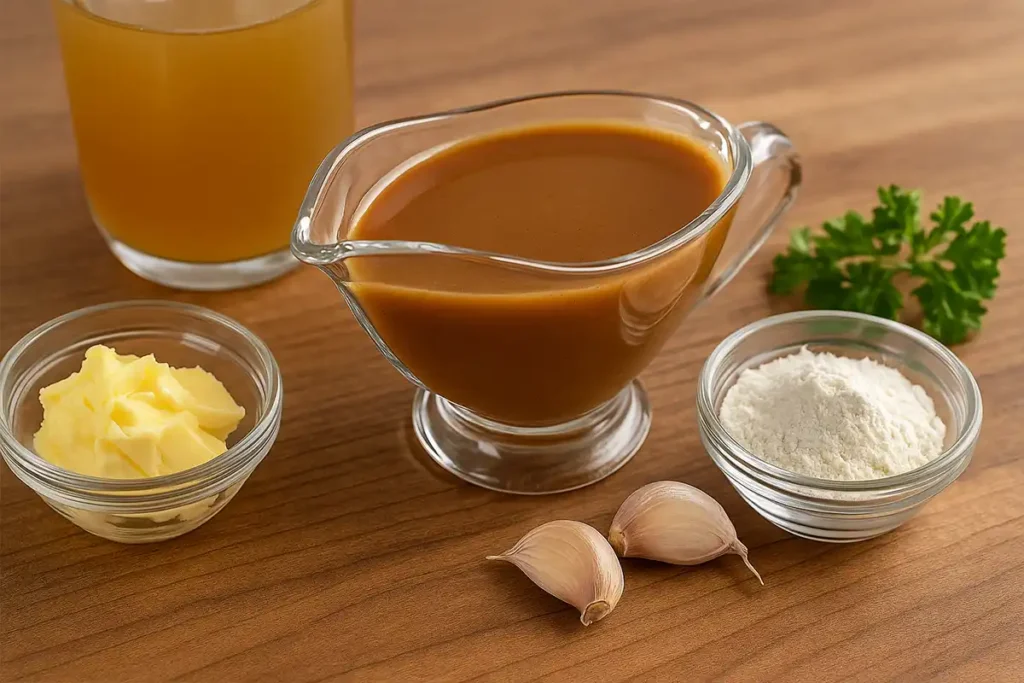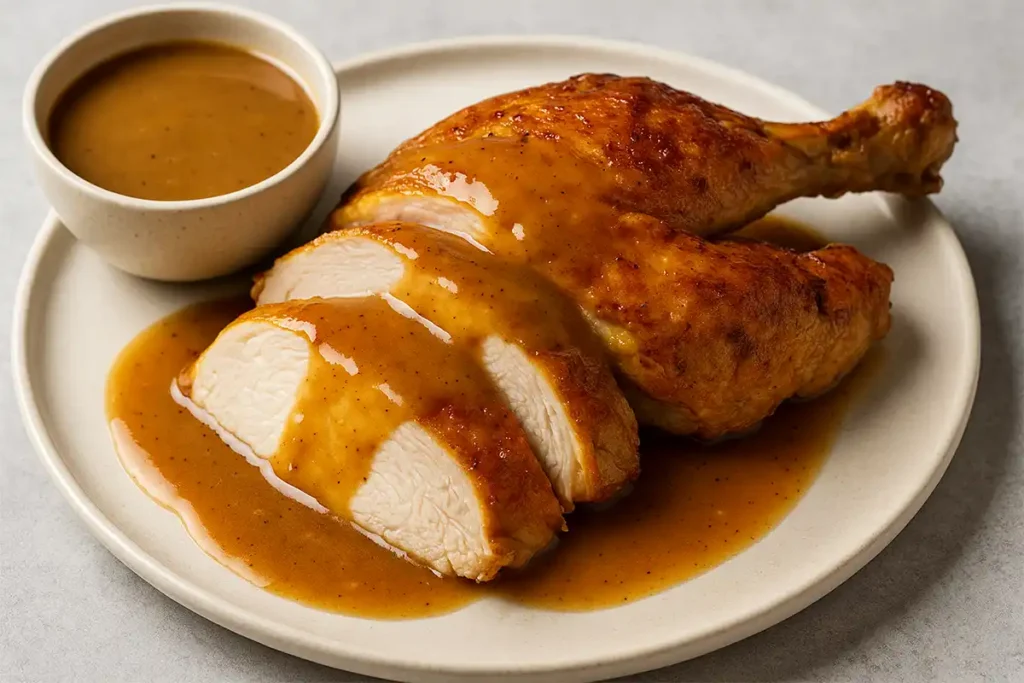There’s something magical about a silky, rich chicken gravy slowly poured over fluffy mashed potatoes or roasted chicken. This article will guide you, step-by-step, on how to make a good chicken gravy—the kind that warms your heart and elevates your entire meal. Let’s dive in!
What Makes a Good Chicken Gravy?
The heart of a good chicken gravy lies in its depth of flavor and silky texture. Whether you’re preparing a simple weeknight dinner or a festive holiday spread, a well-made gravy is the finishing touch that ties everything together.
Why Chicken Gravy Feels So Comforting
There’s something therapeutic about making chicken gravy. Stirring the roux, smelling the broth simmering, and tasting for seasoning… it’s grounding. Cooking this gravy becomes more than just a step in the recipe—it becomes a little ritual of care, warmth, and comfort. If you’re wondering how to make a good chicken gravy that brings calm and comfort, you’re not alone.
Ingredients for a Good Chicken Gravy
These pantry staples are all you need to make magic:
- 2 tablespoons unsalted butter
- 2 tablespoons all-purpose flour
- 2 cups chicken stock or broth (low sodium if store-bought)
- 1/2 teaspoon onion powder
- Salt and freshly ground pepper to taste
- Optional: a splash of soy sauce or a dash of garlic powder

How to Make a Good Chicken Gravy (Step-by-Step)
1. Start With a Roux
Melt butter in a saucepan over medium heat. Add the flour and whisk continuously for 2–3 minutes, until it turns golden and smells slightly nutty. This builds flavor and thickens your gravy later.
2. Add Your Liquid Slowly
Gradually whisk in the chicken broth. This is where you want to be slow and steady—avoid lumps by stirring constantly.
3. Let It Simmer
Bring to a gentle boil, then reduce heat and simmer 5–7 minutes. The gravy will begin to thicken. Add more stock for a thinner texture or simmer longer for a thicker sauce. This is the heart of how to make a good chicken gravy with the right consistency.
4. Taste and Adjust
Add salt, pepper, onion powder, and optional extras. A splash of soy sauce gives extra depth—just a tiny bit!
Secret Tips for Elevating Your Chicken Gravy
- Use chicken drippings if available for maximum flavor.
- Roast garlic and add to the gravy for richness.
- Whisk in a dab of unsweetened Greek yogurt for creaminess without heaviness.
- Make it ahead—flavors deepen overnight in the fridge! These tricks are often overlooked when learning how to make a good chicken gravy.
Health Benefits of Chicken Gravy
While gravy isn’t a “superfood,” using homemade chicken broth brings valuable nutrients like collagen, calcium, and magnesium to the table. Choosing low-sodium stock and skipping additives helps you enjoy it in a wholesome way. Plus, homemade means no artificial flavors or preservatives. Understanding these benefits can be part of why people search for how to make a good chicken gravy.
Therapeutic Benefits of Cooking Chicken Gravy
Let’s not forget the emotional side. Stirring a pot of gravy can feel meditative. The process brings you into the moment, helps reduce stress, and brings back memories of comforting meals with loved ones. Cooking gravy becomes more than a recipe—it’s an act of mindfulness. For many, figuring out how to make a good chicken gravy is tied to emotional wellbeing.
Cultural Origins of Chicken Gravy
Chicken gravy holds a special place in many kitchens around the world. In the Southern U.S., it’s a staple of soul food—comforting, rich, and rooted in family traditions. In parts of Asia, lighter gravies are served with steamed rice or dumplings. Its versatility and warmth make it a cross-cultural symbol of hospitality. These influences shape how to make a good chicken gravy in different homes.
Pairing Chicken Gravy with the Right Foods
Chicken gravy is incredibly versatile. Pair it with roasted chicken, mashed potatoes, steamed vegetables, biscuits, rice, and even over stuffing during holidays. It’s also delicious poured over grilled tofu, lentil loaf, or mushroom steaks for a vegetarian twist.
Storage and Reheating Tips
Let your gravy cool to room temperature, then store it in an airtight container. Refrigerate for up to 4 days or freeze for 3 months. To reheat, gently warm on the stove with a splash of broth or water while stirring. Avoid the microwave for best texture. These steps matter when you learn how to make a good chicken gravy that holds up over time.
Substitutes and Dietary Tweaks
You can easily make chicken gravy gluten-free by using cornstarch or rice flour instead of wheat flour. For dairy-free versions, use olive oil or chicken fat instead of butter. For added protein, stir in shredded cooked chicken or even lentils.
Cooking Chicken Gravy with Kids or Loved Ones
Making gravy can be a fun family activity. Let kids whisk the roux or taste-test for seasoning. Cooking together builds connection, teaches patience, and leaves beautiful memories in the kitchen.
FAQ – Everything About Making Good Chicken Gravy
What is the secret to good gravy?
A perfect roux and high-quality broth. The longer you stir the roux and let it cook, the deeper your flavor. Broth quality is key!
How to make proper chicken gravy?
Melt butter, stir in flour for a golden roux, add broth slowly while whisking, and simmer until thick. Season to taste. That’s it!
What is the one ingredient upgrade for better gravy?
A small splash of soy sauce or roasted garlic. It boosts the umami and brings complexity to the flavor.
Is chicken stock or broth better for gravy?
Chicken stock gives a richer, more gelatinous result, while broth is lighter and a bit more subtle. Use stock for depth!
Pairings and Serving Ideas
- Drizzle it on roasted chicken, mashed potatoes, rice, or turkey.
- Add it to chicken pot pie filling or biscuit-topped casseroles.
- Store in a sealed jar in the fridge for 4–5 days or freeze for future meals.
Final Thought
Gravy isn’t just a side dish—it’s a hug in sauce form. Try making it once, and you might never go back to store-bought again. Now that you’ve learned how to make a good chicken gravy, you’ve got a go-to recipe that brings joy to any meal.

